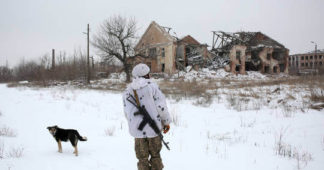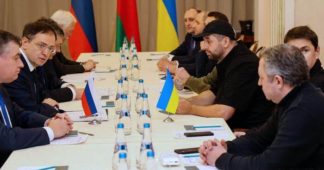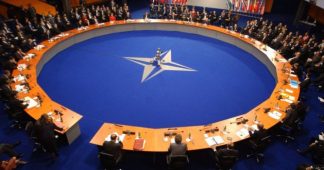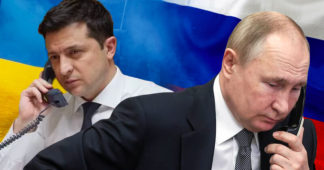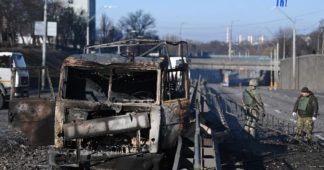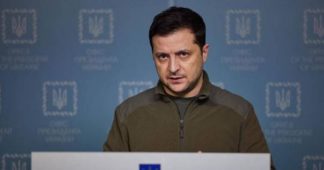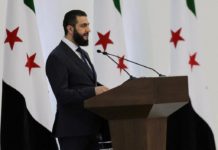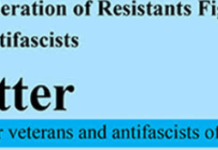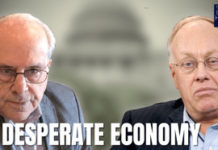Washington loves to see Moscow mired longer in conflicts with Kiev: experts
Wang Qi Mar 17, 2022
Signs of a potential breakthrough showed up a bit amid the Ukraine crisis, as Russia claimed that the neutral status of Ukraine had been discussed in the latest round of bilateral talks. However, the two countries disagreed on the exact model of neutrality, with the Ukraine side saying that it had rejected Russia’s proposal of Sweden’s or Austria’s neutrality, as the model must be “Ukrainian-style.”
Chinese experts viewed the contrary postures as a tussle between Russia and the US: Washington is attempting to make the negotiations last longer, which will cause more costs and losses for Russia, but also more bloodshed in Ukraine.
According to the Financial Times, which cited three people close to the fourth round of bilateral negotiations, a 15-point peace plan has been drawn up by the two sides. The plan would involve Ukraine dropping its aspiration to join NATO and declaring neutrality, in return for a ceasefire and Russia’s army withdrawing.
Russia’s chief negotiator Vladimir Medinsky said on Wednesday that Ukraine had proposed the Austrian and Swedish models of a “neutral and demilitarized state, albeit with its own army and navy,” Russian media reported. However, the model was rejected by Ukrainian top negotiator Mikhailo Podolyak, as the model must have “legally verified security guarantees.”
Analysts said that although there is room for the two sides to compromise on Ukraine’s potential neutrality, huge gaps remain to be solved. As for Ukraine, avoiding the repetition of today’s crisis is the lesson it learned, especially considering the Budapest Memorandum of 1994 on Security Assurance (in which the US, the UK and Russia promised to offer security assurance to Ukraine in exchange for Kiev agreeing to give up the world’s third-largest nuclear arsenal) has failed to work once again this time.
Ukrainian-style neutrality would require the US, the other major Western countries and regions, and Russia to provide more explicit and detailed security guarantees, including clarification of future threats to territorial and sovereign integrity, Wan Qingsong, an expert at the Institute of Russian and Eurasian Studies at East China Normal University, told the Global Times on Thursday.
While for Russia, the neutrality model means “controllable,” especially as a “transit country” independent of the influence and control of the US-led Western world, Wan said, “it also means that Ukraine no longer poses a potential security threat to Russia.”
There is no precedent in international law for the Ukrainian model of neutrality with security guarantees, which means a de facto military alliance, so Russia would not consider that “neutrality,” Zhang Hong, an Eastern European studies expert at the Chinese Academy of Social Sciences, told the Global Times on Thursday.
The Ukrainian model may be more of a negotiating tactic by Kiev, or it may be that the Russian-Ukrainian negotiations were too far apart on the territorial issue, and Kiev tried to extract concessions from Russia through redefining the neutral state, Zhang said.
Russia has not publicly said under what conditions and when it will end the military operation, but the US and the West require Russia to withdraw its troops first before sitting down and discussing the status of Ukraine.
The US’ role in these talks is crucial as Zhang believed that Washington is behind Kiev at the negotiating table, making key decisions.
In a talk with the Secretary of the Russian Security Council General Nikolay Patrushev on Wednesday, US National Security Advisor Jake Sullivan toughly laid out the US’ commitment to continue imposing costs on Russia.
“The statement by the US top officials means that Washington does not believe that Moscow’s demands need to be met, or that Russia should just withdraw unconditionally,” Zhang said. “All the US did is to delay the progress of the peace talks, make the war last longer and cause Russia more economic losses.”
Amid the latest peace talks between Russia and Ukraine, US President Joe Biden on Wednesday announced an additional $800 million in military assistance as part of the $13.6 billion aid package for Ukraine, media reported. The package includes 9,000 anti-armor systems, 7,000 small arms, 800 Stinger anti-aircraft systems, 20 million rounds of ammunition, and 100 drones.
“Russia, which has spent a huge amount of money in the military operation, must surely get real results in the Donbas region… But from Ukraine’s point of view, this is impossible to agree to,” Feng Zhongping, director of the Institute of European Studies at the Chinese Academy of Social Sciences, told the Global Times.
“Ukraine is not willing to give up territory for the sake of neutrality. For Ukraine, even with a high degree of autonomy, the Donbas region should remain part of its territory,” the expert said. “However, a continued stalemate could force Russia to make a bigger military move to raise its bargaining chip.”
Before the talks, Ukrainian President Vlodymyr Zelensky conceded that Ukraine is unlikely to join NATO during a virtual address to leaders of the British-led Joint Expeditionary Force on Tuesday, a sign of cooling down of the escalating situation. Russia’s Foreign Minister Sergei Lavrov also showed a positive gesture, saying that “there is some hope of reaching a compromise.”
“It can’t be ruled out that Ukraine would make clear that it will not join NATO in its constitution,” Wan said. “NATO has never explicitly ruled out Ukraine, nor has it ruled out further expansion, which puts pressure on Russia, especially when public support for NATO membership has risen in neutral Sweden and Finland.”
Published at www.globaltimes.cn
We remind our readers that publication of articles on our site does not mean that we agree with what is written. Our policy is to publish anything which we consider of interest, so as to assist our readers in forming their opinions. Sometimes we even publish articles with which we totally disagree, since we believe it is important for our readers to be informed on as wide a spectrum of views as possible.
